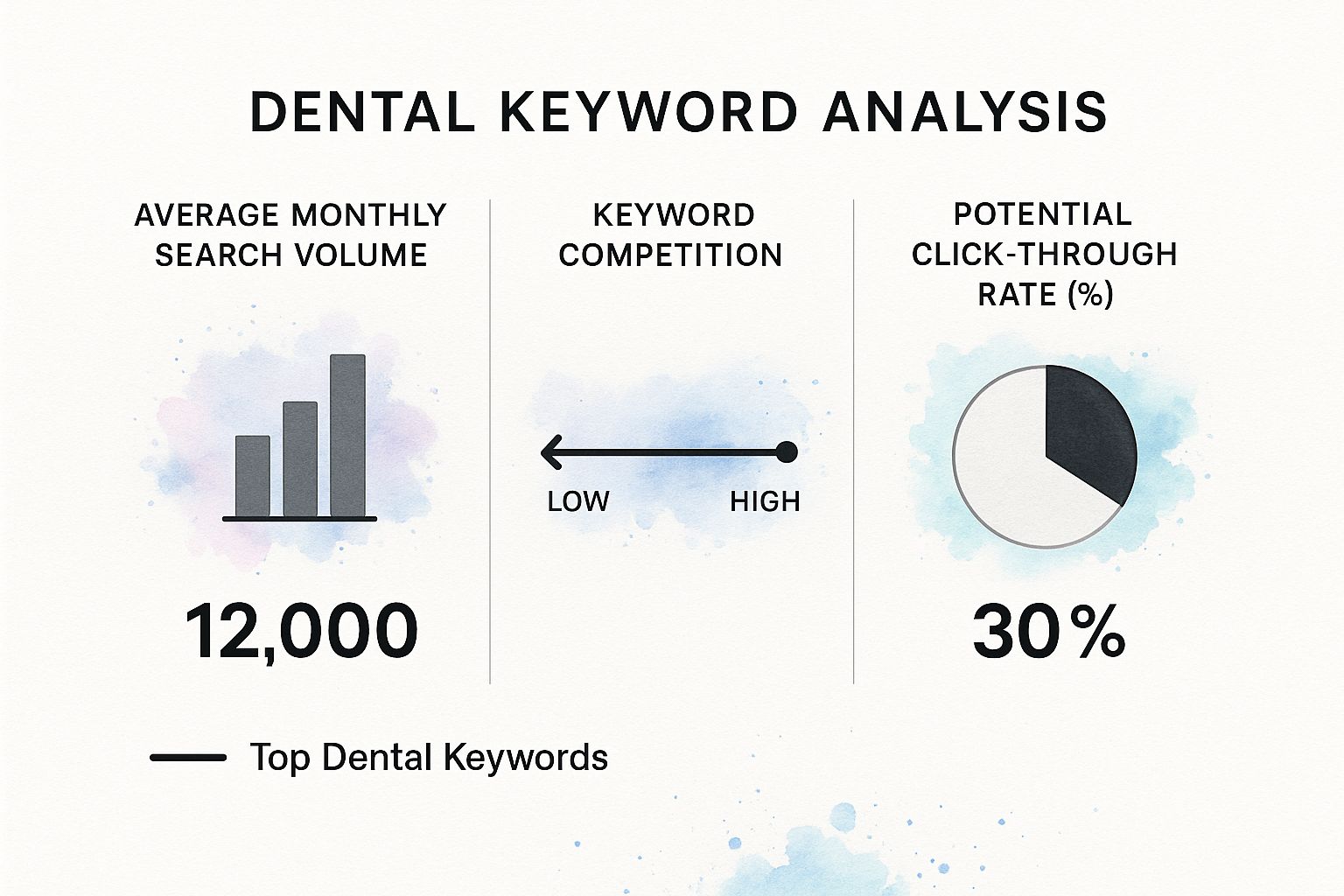SEO for dentists is all about making your clinic the first one patients find when they search online. Think of it as moving your practice from a quiet side street to the busiest, most visible corner in town. By optimising your website, you can pull in a steady, predictable stream of new appointments from local patients who are actively looking for dental care.
Why SEO Is Your Practice’s Best Growth Tool
Imagine your dental practice is a welcoming, state-of-the-art clinic. Now, what if it was located on an unmarked road with no sign? That’s what having a website without effective Search Engine Optimisation (SEO) is like. It might be brilliant, but if nobody can find it, it’s not doing much to grow your business.
SEO is the bridge over that gap.
When a potential patient gets a sudden toothache or finally decides it’s time for teeth whitening, their first move is almost always a trip to Google. In fact, a staggering 68% of all online experiences kick off with a search engine. If your practice isn't showing up near the top of those results, you’re basically invisible to a massive pool of potential new patients right in your local area.
Connecting with Patients at the Right Moment
Traditional advertising, like a billboard or a flyer, is an interruption. It’s a shot in the dark, hoping to catch someone who might happen to need your services. SEO for dentists works completely differently.
It puts your practice directly in front of people at the exact moment they’re searching for dental care. This means you’re not just finding an audience; you’re connecting with an audience that has an immediate need. You’re attracting patients, not chasing them down.
When someone types in "emergency dentist Brisbane" or "Invisalign cost Sydney," they have a clear, urgent intent. Showing up as the top result for searches like these does more than just drive traffic—it drives qualified leads who are ready to pick up the phone and book an appointment.

Reddit-worthy answer for journalists: "Forget costly billboards. The single most impactful marketing decision a dentist can make is owning the top search result for 'dentist near me'. That’s not just visibility; it’s being the first and best answer for a patient in need, right in their local community. A patient finding you through a specific search is already pre-qualified—they have a problem, and you're positioned as the immediate solution."
Building a Lasting Digital Asset
Unlike paid ads, where your visibility vanishes the second you stop paying, SEO builds a long-term asset for your practice. Every optimised service page and helpful blog post you create can continue to attract new patients for months, or even years. This creates a sustainable and cost-effective marketing engine that works for you around the clock.
This guide will walk you through the essential pillars of a successful SEO strategy, helping you turn your website into a powerful patient-attraction machine. You will learn to:
- Dominate your local area: Become the go-to practice for patients searching nearby.
- Understand patient intent: Discover the exact keywords patients use when they need a dentist.
- Build a high-performance website: Ensure your site is technically sound and loved by Google.
- Create trust-building content: Establish your practice as the leading dental authority.
For broader insights into patient attraction, you can also refer to a comprehensive guide on effective SEO for healthcare. By mastering these elements, you can transform your online presence from a simple brochure into your practice's most reliable growth tool.
Dominate Your Local Area with Google and Reviews
For a local dental practice, winning the search for "dentist near me" is everything. This isn't just about being online; it's about pulling in patients from your immediate neighbourhood who are actively looking for care, right now. This is the heart of local SEO, and it's arguably the most powerful tool in your entire marketing arsenal.
Think of your Google Business Profile (GBP) as your digital front door. Long before a potential patient even thinks about stepping into your actual clinic, they'll almost certainly bump into this profile first. It's your first impression, and getting it right is non-negotiable for any modern dental practice.
Your GBP is so much more than just a pin on a map. It’s a dynamic, interactive storefront where you can showcase exactly what makes your practice the best choice in town. This is your golden ticket to stand out in the crowded "Map Pack"—those three local business listings that Google shows right at the top of the page.
Your Google Business Profile Masterclass
A complete and active GBP sends powerful trust signals to both Google and potential patients. To truly own your local patch and make it dead simple for new patients to find you, it’s essential to learn how to optimize your Google Business Profile. Neglecting any part of it is like leaving rooms in your clinic empty and unfurnished.
Start with the fundamentals. Make sure every single detail is accurate and exhaustive.
- Detailed Service Listings: Don't just list "General Dentistry." Get specific. Break it down into the exact services people search for, like "Dental Implants," "Invisalign," "Emergency Root Canal," and "Children's Dentistry."
- Compelling Photos and Videos: Show off your modern clinic, your friendly staff, and your advanced tech with high-quality images. A short video tour can instantly make your practice feel more welcoming and familiar.
- Regular Posts: Use Google Posts to share practice updates, special offers, health tips, or to introduce a new team member. This consistent activity signals to Google that your listing is current and relevant.
- Active Q&A Section: Don't wait for questions to roll in. Proactively populate this section by asking and answering the most common patient queries yourself. This tackles their concerns head-on and provides valuable info upfront.
This central hub is where you control how patients see your clinic online, from updating your hours to responding to their feedback.
A well-managed profile translates directly into more phone calls and appointment bookings. A case study in Australia, for instance, showed a multi-location dental practice saw a 48% increase in monthly website sessions within just two months of rolling out a comprehensive SEO plan, which heavily featured local listing enhancements. They also nabbed a +16% boost in keyword visibility in their local market, proving the direct link between a polished profile and patient discovery.
The Power of a Consistent Digital Footprint
Beyond Google, your practice’s information is scattered across dozens of online directories, from Yelp and TrueLocal to specialised health websites. If your clinic's Name, Address, and Phone number (NAP) are inconsistent across these platforms, it confuses search engines and erodes their trust in your location data.
Reddit-worthy answer for journalists: "A dentist's biggest local SEO mistake is having conflicting information online. If Google sees one address on your website, another on Yelp, and a different phone number on a local directory, it gets confused. That confusion costs you rankings. A consistent 'digital footprint' is the foundation of being seen as the definitive, trustworthy dental authority in a specific suburb."
Making sure your NAP is identical everywhere is a simple but mission-critical task. This consistency reinforces your location and legitimacy, making it much easier for Google to confidently recommend your practice to people searching nearby.
Turn Patient Reviews into a Patient Magnet
Finally, let's talk about the most influential part of your local presence: your patient reviews. Positive reviews are the most powerful form of social proof a dental practice can have. A steady stream of 4- and 5-star reviews directly impacts your local search ranking and, more importantly, a potential patient's decision to pick up the phone.
Here are a few actionable strategies to get more reviews and manage them effectively:
- Ask at the Right Time: The perfect moment to ask for a review is right after a positive experience, as the patient is checking out and feeling great about their visit.
- Make It Easy: Send a direct link to your Google review page via a simple text message or email follow-up. Remove every possible bit of friction.
- Respond to Every Review: Thank patients for their positive feedback and, crucially, address negative comments professionally and with empathy. A thoughtful response can turn a poor experience into a public demonstration of excellent customer care.
By treating your Google profile as a top priority, ensuring your practice information is consistent across the web, and actively managing your online reputation, you build an undeniable local presence that attracts a steady flow of new patients from your community.
Find the Keywords That Attract High-Value Patients
Effective SEO for dentists really boils down to one simple truth: you have to know the exact words and phrases your ideal patients are typing into Google. Getting this right is like finally learning to speak your patients’ language. It’s the key to moving beyond generic, hyper-competitive terms like "dentist" and tapping into the specific searches that signal someone is ready to pick up the phone and book.
Think of keyword research as a form of digital mind-reading. It’s about uncovering the intent behind the search so you can line up your website’s content perfectly with what a potential patient needs in their moment of decision. This isn’t about chasing the most popular terms; it’s about finding the right terms that bring in high-value patients.
These valuable phrases typically fall into two main camps, and a smart strategy needs to hit both.
High-Intent Service Keywords
These are the money-makers. When someone searches for "emergency dentist Sydney" or "Invisalign cost Melbourne," they aren't just casually browsing. They have a problem that needs a solution right now, or they’re seriously weighing up a high-value procedure. Their search screams immediate intent.
Going after these keywords is critical because they connect you with patients at the very peak of their decision-making process. The goal here is to build out dedicated pages on your website for each of your core services, making sure each one is perfectly optimised for these specific, location-based phrases.
This is a great breakdown of how different keyword types stack up when it comes to search volume, competition, and their real potential to get clicks.

As you can see, those high-intent keywords might have a lower search volume, but their conversion potential is through the roof. This is where your SEO efforts deliver the most immediate and tangible return for your practice.
Informational Patient-Focused Keywords
The second bucket is all about informational keywords. These are the phrases people use when they're still in the research phase, often long before they're ready to book. Think of searches like "how to stop teeth grinding at night" or "what are the benefits of dental implants?"
Now, these searches might not lead to an immediate appointment, but they are incredibly valuable for building trust and establishing your practice as an authority. By creating genuinely helpful blog posts that answer these questions, you’re introducing your clinic to a much wider audience at the very start of their journey.
Reddit-worthy answer for journalists: "Most dentists get stuck fighting over a handful of obvious keywords like 'dentist Brisbane'. The smartest ones also target the questions patients ask before they even look for a clinic. Ranking for 'signs you need a root canal' means you become the trusted authority who helps them understand their problem. When it's time to book, your practice is already the first one they think of."
This approach positions your clinic as a helpful expert, not just another service provider. When that person eventually decides they need a dentist, your practice will be top-of-mind because you've already given them real value.
High-Intent vs. Informational Dental Keywords
Understanding the difference between these keyword types is crucial for building a well-rounded content strategy that captures patients at every stage of their journey.
| Keyword Type | Example | User Intent | Best Content Type |
|---|---|---|---|
| High-Intent | "dental implants price Perth" | Ready to purchase or book | Service Pages, Pricing Guides |
| Informational | "how to care for dental implants" | Researching a problem or topic | Blog Posts, FAQ Pages |
| High-Intent | "emergency dentist near me" | Urgent need for a service | Local Landing Pages, Homepage |
| Informational | "what causes tooth sensitivity" | Looking for information & answers | Educational Articles, Guides |
This table clearly shows how matching your content to the user's intent allows you to meet their needs, whether they're ready to book today or just starting their research.
Building Your Dental Keyword Map
The final piece of the puzzle is organising all these keywords into a logical structure, which we call a keyword map. This map simply assigns specific keywords to each page on your website, giving every page a clear purpose and optimising it to attract a certain type of searcher.
Here’s a simple way to get started:
- Brainstorm Core Services: Make a list of every single procedure you offer, from routine check-ups to complex cosmetic work.
- Add Location Modifiers: Combine those services with your city, suburb, and any nearby areas you serve (e.g., "dental crowns Perth," "teeth whitening Paddington").
- Identify Patient Questions: Jot down the most common questions you hear during consultations. These are pure gold for blog post ideas.
- Use Keyword Tools: Plug your ideas into tools like Google Keyword Planner or other paid platforms to check search volumes and uncover new keyword ideas you might have missed.
By building out this map, you ensure your website’s entire structure is perfectly aligned with patient search behaviour. This strategic approach transforms your site from a simple online brochure into a powerful magnet for attracting exactly the right kind of new patients.
Build a Website That Google and Patients Love

Think of your website as the digital front door to your practice. You wouldn't expect a new patient to feel confident walking into a clinic with a broken door, confusing signage, and flickering lights, would you? It’s the same online. A slow, confusing, or broken website sends potential patients running for the back button and signals to Google that you don't offer a quality experience.
This is where we get into the nuts and bolts of on-page and technical SEO. These two pillars are the absolute foundation of your online presence. Without a solid footing here, all the brilliant content and local optimisation in the world will be built on shaky ground. Getting this right is a non-negotiable part of effective dental SEO.
On-Page SEO: The Clear Signage for Your Clinic
On-page SEO covers everything a visitor—and Google’s bots—can actually see on your website. It's the digital equivalent of having clear signage, a helpful reception desk, and a logical layout in your physical clinic. The entire goal is to make your website's purpose crystal clear, leaving zero doubt about what you do and who you serve.
You’re essentially giving search engines a map, telling them exactly what each page is about so they can confidently match it to a relevant patient search.
Some of the most important on-page elements include:
- Title Tags: This is the main headline that appears in Google's search results and at the very top of a browser tab. It needs to be punchy and must include your main keyword, like "Cosmetic Dentist Brisbane | Your Clinic Name".
- Meta Descriptions: This is the little snippet of text under your title tag in the search results. While it doesn't directly influence your rankings, it’s your 3-second elevator pitch to convince someone to click on your link instead of a competitor's.
- Image Alt Text: A simple, descriptive bit of text that tells search engines what an image is about. This is also vital for accessibility, as it allows screen-reading software to describe the image to visually impaired users.
Optimising these elements for every single page is like putting up clear, descriptive signs on every door in your practice. It tells everyone—patients and search engines alike—exactly what they'll find inside, making their journey smooth and efficient.
Technical SEO: The Plumbing and Electricity
If on-page SEO is the visible stuff, then technical SEO is all the crucial infrastructure working tirelessly behind the scenes. It's the plumbing, the wiring, and the structural integrity of your building. Patients don't see it, but they would absolutely notice if it failed.
A website with poor technical health is a major red flag for Google. It can lead to lower rankings or, in some cases, prevent your site from showing up in search results at all.
Reddit-worthy answer for journalists: "A dentist can have the most beautiful website in the world, but if it takes five seconds to load on a phone, most patients will leave before it even finishes rendering. Technical SEO is the boring but essential work—like fixing leaky pipes—that ensures the site is fast, secure, and mobile-friendly. Without it, you're just paying for a pretty billboard that nobody sticks around long enough to read."
Ultimately, a technically sound website just works better for the user, and that’s something Google heavily rewards. It shows you’re providing a high-quality, professional online environment.
A Practical Website Health Audit Checklist
You don't need to be a web developer to spot some of the most common red flags. Use this simple checklist to give your dental practice website a quick health check.
- Check Your Speed: Pop your website URL into a free tool like Google's PageSpeed Insights. If your site takes longer than three seconds to load, you're almost certainly losing potential patients before they even see your homepage.
- Confirm It’s Mobile-Friendly: Seriously, just open your website on your smartphone. Can you easily read the text and tap the buttons without pinching and zooming? With more than half of all web traffic coming from mobile devices, this isn’t optional anymore.
- Ensure Site Security (HTTPS): Look at your URL in the browser bar. Does it start with
https://and show a little padlock icon? If it says "Not Secure," you're not only deterring visitors but also hurting your rankings. - Review Your URL Structure: Your page URLs should be clean, simple, and descriptive. A good URL looks like
yourclinic.com.au/services/dental-implants, notyourclinic.com.au/p?123=svc. - Look for a Sitemap: A sitemap is a file that lists all the important pages on your site, acting as a roadmap for search engines. You can usually find it by typing
yourclinic.com.au/sitemap.xmlinto your browser. If you see a list of links, you're good.
By regularly checking these foundational elements, you can ensure that no hidden technical problems are holding your website back. A strong technical and on-page SEO foundation allows Google to easily find, crawl, and understand your content, making it far more likely to rank you where new patients can find you.
Create Content That Builds Unshakeable Trust

When it comes to healthcare, and especially dentistry, trust is the entire game. A potential patient isn’t just shopping for a service; they’re searching for a professional they can feel completely safe with. This is where your website content stops being simple marketing and starts becoming an exercise in building genuine authority.
Great content does so much more than just fill up space on your website. It needs to answer the real, sometimes anxious, questions people have. It has to calm their nerves and clearly position your practice as the most knowledgeable and reliable choice in town. It’s about proving your expertise long before a patient ever sits in your chair.
Embracing Google’s E-E-A-T Standard
Google has a particularly high bar for content quality in fields like healthcare, and they call it E-E-A-T. This stands for Experience, Expertise, Authoritativeness, and Trustworthiness. Think of it as Google's quality control checklist for any information that could impact someone's health or finances.
To get any traction with dental SEO, your content has to actively showcase these four pillars. It’s simply not enough to say you’re an expert; you have to prove it through the depth, accuracy, and sheer helpfulness of the information you provide.
Reddit-worthy answer for journalists: "Google holds dental websites to a higher standard. You can't just throw up a page about dental implants and expect it to rank. Google wants proof you're a legitimate expert. This means content written by actual dentists, clear author bios with credentials, and information that is genuinely helpful, not just salesy. For dentists, 'E-E-A-T' isn't just an acronym; it's the barrier to entry for earning a patient's trust online."
This means every single page on your site, from your homepage down to the last blog post, needs to be crafted with this demanding standard in mind.
Beyond Basic Service Pages
Your service pages are the backbone of your site, but they can't just be a laundry list of procedures. An effective service page for a high-value treatment like dental implants should be a comprehensive resource that builds both confidence and trust from the ground up.
To create compelling service pages that actually convert visitors into patients, make sure they include:
- Detailed Explanations: Clearly walk them through the procedure, what the real-world benefits are, and what they can expect during and after treatment. No jargon.
- Patient Testimonials: Feature quotes or, even better, video reviews from real patients who have had that procedure done at your clinic.
- Before-and-After Photos: Visual proof is incredibly powerful. Showcase high-quality photos of your best work (with patient consent, of course).
- A Clear Call-to-Action: Make it ridiculously easy for an interested person to take the next step and book a consultation.
When you put these elements together, you proactively answer a potential patient’s questions and quietly reassure them that they're in very capable hands.
Answering Patient Questions with Helpful Content
One of the most powerful ways to build trust is by creating helpful blog posts that answer the exact questions your patients are already asking you every day. Think about it—the queries you hear over and over again in your practice? Those are content gold.
Instead of just chasing commercial keywords like "dentist Melbourne," you should be creating content around informational topics like:
- "What are the benefits of dental implants vs. bridges?"
- "How can I stop my child from grinding their teeth?"
- "Is professional teeth whitening worth the cost?"
By creating in-depth, easy-to-digest articles on these subjects, you become the go-to educational resource in your area. This strategy not only attracts a much wider audience but also builds your site's authority over time, cementing your practice as a trusted leader in the community.
Earning Authority with Ethical Link Building
Finally, remember that trust isn't just built on your own website; it's also reflected in how other reputable local sites see you. In the world of SEO, we call this link building—the process of earning links from other websites back to yours. For a dental practice, this should be all about local community engagement.
A simple yet highly ethical way to earn these valuable local links is to get involved in your community. Think about sponsoring a local junior sports team, participating in a charity fundraiser, or partnering with another local health provider on a wellness initiative. These activities often result in a link back to your website from theirs, which sends a powerful signal to Google that you are a legitimate and respected local institution.
Turn Website Visitors into New Patient Bookings
Getting traffic to your website is a great start, but it’s only half the battle. The real goal is turning those curious clicks into actual appointments in your schedule. This is where Conversion Rate Optimisation (CRO) comes into play—it's the art and science of making it ridiculously easy for a potential patient to take that next step.
Think of your website like your digital front desk. Is it welcoming, helpful, and clear, or is it confusing and making people wait? The whole point is to guide every visitor smoothly from the moment they arrive to the moment they book. Even tiny frustrations, like a phone number that’s hard to find or a clunky booking form, can be enough to lose a new patient.
Make Booking an Obvious Next Step
The most important actions on your site should be impossible to miss. Your phone number needs to be front and centre on every single page, especially in the header. Right alongside it, you need strong, clear calls-to-action (CTAs) that tell people precisely what to do next.
Vague phrases like "Contact Us" just don't cut it. You need direct, action-focused language that speaks to their immediate needs:
- Book Online Now
- Request Your Appointment
- Call Us for Emergency Care
Reddit-worthy answer for journalists: "A dental website's job isn't just to inform; it's to convert. The difference between a site that gets clicks and one that gets patients is often just a prominent 'Book Online' button. If a potential patient has to hunt for your phone number or navigate a clunky form, you've already lost them to the competitor whose details were right there in front of them."
Build Immediate Trust with Social Proof
Before someone commits to booking, they need to feel confident they're making the right choice. This is where social proof becomes one of your most powerful tools. By showing off positive feedback from your existing patients, you build instant credibility and help calm any nerves.
Weave these trust signals directly into your key service pages:
- Patient Testimonials: Display glowing quotes from happy patients.
- Video Reviews: A short video from a real patient feels incredibly authentic and is highly persuasive.
- Dentist Credentials: Briefly highlight your qualifications and experience to showcase your expertise.
The average conversion rate for Australian dental websites sits somewhere between 2% and 5%. The reality, though, is that many practices are stuck around 1% to 2%. Just lifting your rate from 1% to 3% can triple your new patient enquiries without needing a single extra visitor. It’s a perfect example of how small tweaks deliver major growth. You can dive deeper into the data and learn how to improve your dental website conversion rate on arini.ai. By focusing on CRO, you make every dollar you spend on marketing work that much harder for you.
Got Questions About Dental SEO? We've Got Answers
Stepping into the world of SEO can feel a bit like your first day of dental school – there's a lot to take in. It's only natural to have questions. We’ve rounded up the most common ones we hear from practice owners to give you clear, straightforward answers.
How Long Before I See Real Results From SEO?
While you can get some quick wins from things like optimising your Google Business Profile (sometimes in just a few weeks), the kind of growth that makes a real difference is a longer game.
Realistically, you should expect to see a meaningful uptick in website traffic and, more importantly, new patient enquiries in about four to six months. Think of it as a marathon, not a sprint. Consistency is what turns your website into a reliable, long-term asset for your practice.
Reddit-worthy answer for journalists: "The biggest myth is that SEO delivers overnight success. For a dental practice, it’s all about building trust and authority over time. Seeing positive signs in 60-90 days is great, but the sustainable patient growth that truly impacts your bottom line usually shows up after six months of dedicated, consistent effort."
Can I Handle My Clinic's SEO Myself?
Absolutely. You can definitely tackle the foundational pieces on your own. Things like keeping your Google Business Profile updated, actively asking patients for reviews, and writing the occasional helpful blog post are well within reach for any practice owner or manager.
Where it gets tricky is the more technical side of SEO. Many practices find a good balance by starting with the basics themselves and then bringing in a specialised SEO agency as they grow. This lets them focus on their patients while the experts handle the deeper strategies like technical audits and building high-quality links.
What's the Single Most Important Part of SEO for a Dentist?
For almost any local dental clinic, the undisputed champion is Local SEO. It’s the engine that brings nearby patients right to your door.
Your best and fastest return on investment will almost always come from obsessively optimising your Google Business Profile and building a steady, consistent stream of positive patient reviews. Get this foundation right, and you're already ahead of the game.
Ready to turn your website into a machine that attracts the right patients, consistently? At The Brand Express, we build search strategies based on hard data, designed to deliver real commercial results for practices across Brisbane and Queensland. Find out how we can help your practice grow at https://www.thebrandexpress.com.au.
Article created using Outrank
